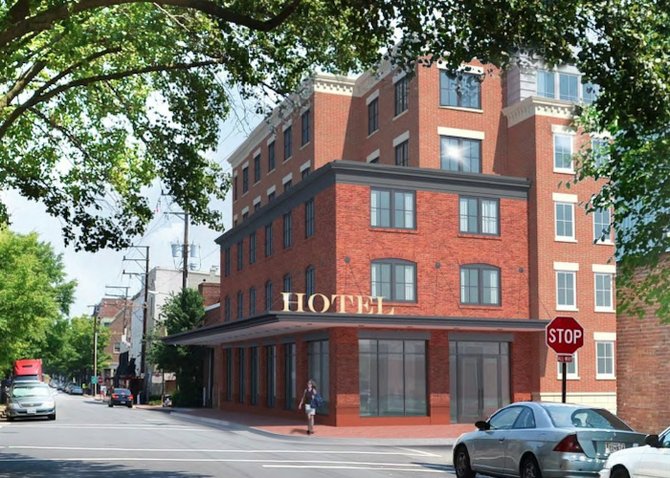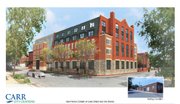The proposed building height ranges from 30 feet to 50 feet, which is three stories on part of the site and five stories on another.
Last year, the Board of Architectural Review sent Carr Hospitality back to the drawing board on its proposal to build a 121-room hotel on the waterfront. Members said the proposal was too massive for the scale of the neighborhood at the foot of Duke Street. Now the Washington-based developer is back with a 120-room hotel, and members of the Board of Architectural Review are just as frustrated with the concept.
"I think it's too much, too big," said Tom Hulfish, chairman of the Old Town Board of Architectural Review. "I don't think Alexandria should make a mistake at this time, one that will be very hard to correct in the future."
The stakes are high for all involved. For the board, they must approve a design that will set the stage for a wave of future development envisioned by the waterfront small-area plan — a proposal opposed by many neighbors that almost triples density at three sites compared to what's there now. For the developer, it's an opportunity to cash in on a zoning change that potentially enhances profits. That's why the mass and scale of the building remains largely intact, although the revised concept plan ditches the covered carriageway and closed courtyard that were part of the original proposal.
"We came to the conclusion that we could provide an alleyway and courtyard all the way through the block that was completely open to the sky," said architect Mark Orling, who is working with Carr Hospitality. "And really that's the major change in terms of the plan."
THE CUMMINGS PROPERTY is one of the three sites slated for redevelopment that were at the heart of the waterfront small-area plan, an increase of density that aggravated neighbors so much they filed a series of lawsuits to stop the city from moving forward. All of the challenges were swept aside, though, and now Carr Hospitality has the green light to move forward with its development plans — if they are approved. The developer must now seek approval from a gauntlet of boards and commissions, culminating in a development special-use permit from the Alexandria City Council.
"This is not just a hotel on a piece of land," said Christine Merdon, who lives next to the Cummings property. "The rest of the waterfront will fall in line with the way this is developed."
Speaker after speaker said the building was too large, a scale that was out of proportion for Old Town. Some speakers criticized the architectural details of the building, a list of grievances that includes everything from the design of the roof to the location of trash removal. Only two speakers supported the plan, both of whom were leaders of a group called Waterfront for All that was organized to support the increase in density.
"I'm very excited about the opportunity to have a hotel on the waterfront, to be able to have dinner there and to have my guests and friends stay at this hotel," said Lynn Hampton, one of the founders of Waterfront for All. "I think the Carr development company has listened very closely to the citizens of Alexandria and have reacted to make sure there is something that fits within the parameters of what we want."
THE HISTOR OF THE property dates back to the earliest days of the city, a time when city leaders extended the waterfront east into the river to create a zone for commerce. About half of the property was underwater when Alexandria was founded in 1749, although the parcel had been completely filled in by 1845. Originally, it had a warehouse with piers running east to the Strand. The current warehouse structure on the property was constructed in the 1950s.
"Historically, waterfront buildings, often warehouses, were significantly larger and less high-style than buildings in other parts of the city," according to the staff report on the proposal. "Warehouses were often four stories in height and occupied the entire lot, without setbacks or open space."
For Carr Hospitality, one of the problems is threading the needle of opposing interests. The developer must please members of the general public and city officials as well as a host of elected and appointed members to boards and commissions. The proposal must also meet the guidelines in the waterfront small-area plan, a vision that exists in physical form as a model that is brought out and displayed at City Hall every time a potential development is considered.
"And so what the architect has done is that he's tried to satisfy both sides. He's tried to make it a warehouse, but then he's tried to break it up to reduce the mass," said Oscar Fitzgerald, vice chairman of the Board of Architectural Review. "So essentially everybody's unhappy."
CITY GUIDELINES call for materials and design to be appropriate for the history of the neighborhood while still meeting modern standards. Carr Hospitality's approach to that challenge has been to offer a variety of forms and materials. One part of the building has paired windows while another part has single windows. One section has a mansard roof although another had dormers and a flat roof. The first floor has large plate-glass storefront windows while the upper stories have punched window openings in load-bearing masonry walls.
"The design is incoherent," said Christine Roberts, one of the newest members of the board. "It's completely different form the Strand Street elevation to the Union Street elevation."
"So is the model," the architect responded, gesturing toward the model on display before the dais. "I would feel perfectly comfortable going with one coherent type of architecture. I think that my client would really appreciate doing that because they want a single style of building. But, again, we were working from a model that shows two discrete types of warehouse structures.

